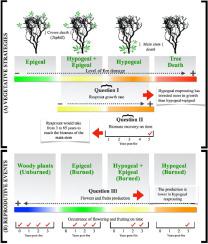Basic and Applied Ecology ( IF 3.8 ) Pub Date : 2021-06-12 , DOI: 10.1016/j.baae.2021.06.005 Letícia Gomes , Eddie Lenza , Fabiane Furlaneto Souchie , José Roberto Rodrigues Pinto , Leonardo Maracahipes-Santos , Marco Túlio Furtado , Leandro Maracahipes , Divino Silvério

|
Resprouting is an efficient life history strategy by which woody savanna species can recover their aboveground biomass after fire. However, resprouting dynamics after fire and the time it takes to start producing flowers and fruits are still poorly understood, especially for the Brazilian savanna (Cerrado biome), where fire is an important driver of vegetation structure and ecosystem functioning. We investigated the resprouting dynamics and production of flowers and fruits of 26 woody species (20 tree and 6 shrub species for a total of 485 individuals) that were burned and the production of flowers and fruits for a subset of 12 species (139 individuals) in an unburned area in a Brazilian savanna. We classified the species’ resprouting strategies as hypogeal (at the soil level, with main stem death), epigeal (on the main stem or crown), and hypogeal + epigeal. We used generalized linear mixed-effect models to identify the post-fire recovery patterns for five years. Individuals with basal resprouts (hypogeal and hypogeal + epigeal resprouting) produced an average of 6 basal resprouts, but only 33% of resprouts survived after five years. Individuals in burned areas produced fewer flowers and fruits than individuals in unburned areas. At least a subset of individuals in all the resprouting strategies started to produce flowers and fruits in the first-year post-fire. About 68% of the species with hypogeal resprouts produced flowers and fruits in the first-year post-fire, but the intensity of flowering and fruiting was lower compared to individuals with other resprouting strategies over time. Although woody species have invested in post-fire growth and sexual reproduction in all resprouting strategies, the long time needed to recover these processes can make these species more vulnerable to frequent fires.
中文翻译:

巴西稀树草原中木本物种的长期火灾后重新发芽动态和繁殖
重新发芽是一种有效的生活史策略,通过它木本稀树草原物种可以在火灾后恢复其地上生物量。然而,火灾后的重新发芽动态以及开始生产鲜花和水果所需的时间仍然知之甚少,特别是对于巴西热带稀树草原(塞拉多生物群落)而言,火是植被结构和生态系统功能的重要驱动因素。我们调查了被烧毁的 26 种木本树种(20 种乔木和 6 种灌木,共 485 只)的花朵和果实的重新发芽动态和生产情况,以及 12 种(139 只个体)亚组的花和果实的生产情况。巴西稀树草原中未燃烧的区域。我们将物种的重新发芽策略分类为下胚层(在土壤水平,主茎死亡)、上胚层(在主茎或树冠上)、和hypogeal + epigeal。我们使用广义线性混合效应模型来确定五年来的火灾后恢复模式。具有基部再芽(下胚和下胚 + 上胚再芽)的个体平均产生 6 个基部再芽,但只有 33% 的再芽在 5 年后存活。燃烧区域的个体比未燃烧区域的个体产生更少的花和果实。在所有重新发芽策略中,至少有一部分个体在火灾发生后的第一年开始生产花朵和果实。在火灾后的第一年,大约 68% 的具有胚芽重芽的物种产生了花朵和果实,但随着时间的推移,与采用其他重芽策略的个体相比,开花和结果的强度较低。


























 京公网安备 11010802027423号
京公网安备 11010802027423号